A Description of the Sanctuary Windows of the United Methodist Church of East Meadow
The windows, designed for our church by the Willet Studios, were executed in one of their techniques, faceted glass. The glass in the windows is between one and two inches thick. This necessitates its being chopped with hammers to the correct shape and size. Then it is joined with a matrix of epoxy resin. The thickness of the glass and the faceted edges are responsible for the brilliance.
The windows are in a rich palette with blues and rubies dominating to create a liturgical effect in the church by means of symbols. They tell the high points of the Old and New Testaments, with the last window devoted to the present. The use of symbols recalls the history of the Christian Church, which has consistently used its arts to instruct as well as beautify. The first window is nearest the entrance on the Gospel side (south), continuing toward the altar (east). The chronology of the Epistle side (north) extends from the altar back to the rear.
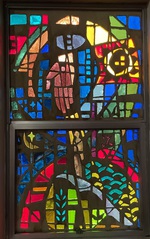
1. The Creation: God’s hand extends from above in the act of creating the world. It is flanked by sun, moon and stars. Below are land and sea. At the center, just under the protection of God’s hands, is the human.
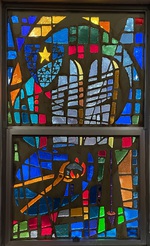
2. The Law and the Prophets: Abraham is symbolized by a shield containing a large star surrounded by small stars. This recalls God’s promise to multiply his descendants until they are as numerous as the stars in the sky and the sands of the sea. There happens to be twelve tribes of Israel, but it should be remembered that they were Jesse’s sons, not Abraham’s. Central in the window are the Tablets of the Law given by God to Moses on Mt. Sinai. Below, the tongs hold a burning coal from the altar of Sacrifice with which the seraphim sealed Isiah’s lips, purifying him to enable him to prophecy. The plumb line is one of Amos’ symbols. It is given to him because he saw God holding a plumb line in the midst of the Children of Israel to remind them of his judgement.
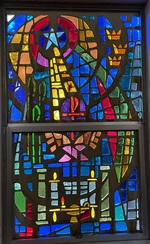
3. The Incarnation: At the center of this window is a manger containing a Chi-Rho, the sacred monogram for Jesus Christ. Above is the star of Bethlehem. On either side are the shepherds’ staves and three kings’ crowns. Below the lighted lamp and Torah scroll, between pillars, symbolize the visit to the Temple by the twelve year old Jesus.
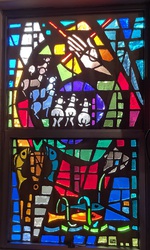
4. The Beginning of Jesus’ Ministry: At the bottom, the escallop shell of Baptism pours water down upon fish. When John baptized Jesus the old ritual of washing away of sins was transformed into a new rite. Opposite the shell may be seen a device derived from an ancient ringstone, a basket containing a fish with two other fish drawing near to enter in their turn. This represents Jesus calling the fisherman to be fishers of men. At the top, the hand of Jesus is raised in benediction over sheep recalling the Good Shepherd who knows his sheep. The sheep, seen as lambs, may also symbolize children, so loved by our Lord, who said, “Let the children come to me, do not hinder them; for to such belong the Kingdom of God.”
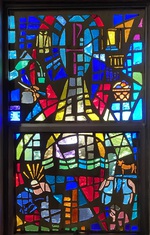
5. The Ministry Continues: This window emphasizes Jesus’ teaching. At the center, the Chi-Rho is placed on a stylized mountain top, reminding us of the Sermon on the Mount. Flanking this near the top of the window are the Acts of Mercy derived from the twenty fifth chapter of Matthew: feeding the hungry, giving drink to the thirsty, clothing the naked, visiting the sick (basket of fruit and books), releasing the prisoner and welcoming the stranger.
At the bottom, two parables are represented. On the left is the pearl of great price. To be able to buy it, a merchant will see all his property. On the right, the hands of the forgiving father reach out to the Prodigal Son. Above is the fatted calf.
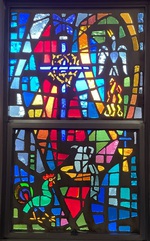
6. Christ’s Passion, Death and Resurrection: At the bottom is the cup with the cross of suffering which Jesus prayed to have removed in the Garden of Gethsemane. At the center is the basin and pitcher with which Pilate washed his hands. This cock is the one that crowned when Peter denied Christ, but symbolizes the constant denial through the world’s sins as well.
The cross encircled with a crown of thorns, the Crucifixion, and the phoenix are equally predominant. The ancients thought that the mythical phoenix, instead of dying, set the fire to its nest and rose rejuvenated from the flames. The butterfly at the top symbolizes not just Christ’s Resurrection, but also universal life after death. Life on Earth is like that of a caterpillar. The cocoon is the grave from which the butterfly emerges flying upward on beautiful wings.
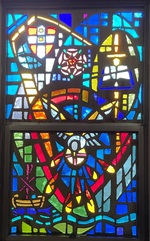
7. Pentecost and the Ongoing Church: At the center of the Holy Spirit descends to the Church. The flames are those that topped the heads of the faithful at Pentecost. The Church is symbolized by a ship with a Chi-Rho on the mast. Attached to the hull is the mythical fish called remora. The remora was thought by the ancients to be a small fish of super natural strength, able to fasten itself to the keel of a ship to keep it from rolling or pitching even in the most violent tempests. This is used in art as a symbol of Jesus who protects the ship of the Church. Above is the open book and sword of the spirit, symbol of Paul derived from the sixth chapter of Ephesians, the heraldic rose which is Luther’s seal and Wesley’s coat of arms superimposed over a clock, with hands pointing to quarter of nine which was Wesley’s “hour of decision” at the meeting on Aldersgate Street.
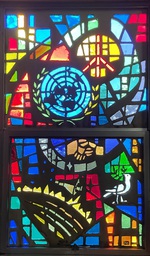
8. The Church is the World Today: The seal of the United Nations needs no explanation. The peace symbol has grown very popular. Several explanations are given for it. One of these is that it is the semaphore letters for N D – nuclear disarmament. Clasped hands symbolize brotherhood. At the bottom left, the Apollo space craft rises above the earth’s surface. Also included is a very traditional symbol of peace, a dove with an olive branch in its mouth.

